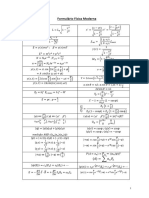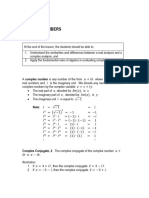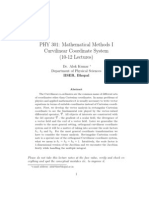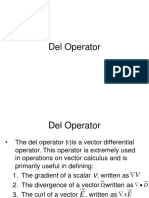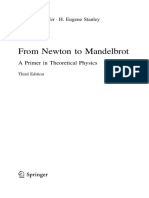Module 1-Vector Calculus
Uploaded by
themonarchofmenaceModule 1-Vector Calculus
Uploaded by
themonarchofmenaceMODULE-2
VECTOR CALCULUS
Vector calculus is a field of mathematics concerned with multivariate real analysis of vectors in
two or more dimensions. It consists of set of problems solving techniques very useful for engineering
and physics.
SCALAR AND VECTOR POINT FUNCTIONS
Let 𝐹⃗ (𝑡) = 𝑓1 (𝑡)𝑖̂ + 𝑓2 (𝑡)𝑗̂ + 𝑓3 (𝑡)𝑘̂ be a ‘Vector function’. Then for various values of 𝑡 we get a
set of constant vectors.
Let 𝜑 = 𝜑(𝑥, 𝑦, 𝑧) be a ‘Scalar function’. Then for various values of 𝑥, 𝑦, 𝑧 we get a set of points
or scalars.
Vector operation 𝛻(𝑑𝑒𝑙) is defined by the equation
𝜕 𝜕 𝜕
𝛻= 𝑖̂ + 𝑗̂ + 𝑘̂
𝜕𝑥 𝜕𝑦 𝜕𝑧
This operator has a great role in vector calculus. Laplacian operator 𝛻 2 is defined as follows
𝜕 𝜕 𝜕 𝜕 𝜕 𝜕
𝛻 2 = 𝛻. 𝛻 = ( 𝑖̂ + 𝑗̂ + 𝑘̂ ) . ( 𝑖̂ + 𝑗̂ + 𝑘̂ )
𝜕𝑥 𝜕𝑦 𝜕𝑧 𝜕𝑥 𝜕𝑦 𝜕𝑧
𝟐 𝟐 𝟐
𝝏 𝝏 𝝏
𝜵𝟐 = 𝟐 + 𝟐 + 𝟐
𝝏𝒙 𝝏𝒚 𝝏𝒛
Gradient
The vector function 𝛻𝜑 is defined as the gradient of the scalar function 𝜑 = 𝜑(𝑥, 𝑦, 𝑧)
𝜕 𝜕 𝜕
𝑖. 𝑒. , 𝑔𝑟𝑎𝑑𝜑 = 𝛻𝜑 = (𝜕𝑥 𝑖̂ + 𝜕𝑦 𝑗̂ + 𝜕𝑧 𝑘̂ ) 𝜑
𝝏𝝋 𝝏𝝋 𝝏𝝋
̂)
𝒈𝒓𝒂𝒅𝝋 = 𝜵𝝋 = ( 𝝏𝒙 𝒊̂ + 𝝏𝒚 𝒋̂ + 𝝏𝒛 𝒌
Geometrically, 𝛻𝜑 represents a normal at any point P to the surface 𝜑(𝑥, 𝑦, 𝑧) = 𝑐𝑜𝑛𝑠𝑡𝑎𝑛𝑡 and
has a magnitude equal to the rate of change of 𝜑(𝑥, 𝑦, 𝑧) along this normal. 𝛻𝜑 is a vector quantity.
Note:
𝜵𝝋 𝛻𝑓
̂ = |𝜵𝝋| or 𝑛̂ = |𝛻𝑓|
1. The unit normal vector 𝑛̂ along 𝛻𝜑 is given by 𝒏
2. The component of 𝛻𝜑 in the direction of a unit vector 𝑎⃗ is 𝛻𝜑. 𝑛̂ and is called the directional
derivative of 𝜑 in the direction of 𝑎⃗. Thus, the directional derivative is maximum in the direction 𝛻𝜑
and the magnitude of this maximum is equal to |𝛻𝜑|.
𝑎⃗⃗
̂
𝑖. 𝑒., 𝑫. 𝑫 = 𝜵𝝋. 𝒏 where 𝑛̂ = |𝑎⃗⃗|
ADVANCED CALCULUS AND NUMERICAL METHODS-21MAT21 1
Problems
1. Find the unit normal vector to the surface 𝑥 3 + 𝑦 3 + 3𝑥𝑦𝑧 = 3 at (1,2, −1).
Sol: Let 𝜑 = 𝑥 3 + 𝑦 3 + 3𝑥𝑦𝑧 − 3
𝜕𝜑 𝜕𝜑 𝜕𝜑
𝜕𝑥
= 3𝑥 2 + 3𝑦𝑧 𝜕𝑦
= 3𝑦 2 + 3𝑥𝑧 𝜕𝑧
= 3𝑥𝑦
𝜕𝜑 𝜕𝜑 𝜕𝜑
Now, 𝛻𝜑 = ( 𝑖̂ + 𝑗̂ + 𝑘̂)
𝜕𝑥 𝜕𝑦 𝜕𝑧
𝛻𝜑 = (3𝑥 2 + 3𝑦𝑧)𝑖̂ + (3𝑦 2 + 3𝑥𝑧)𝑗̂ + (3𝑥𝑦)𝑘̂
At (1,2, −1)
𝛻𝜑 = (3 − 6)𝑖̂ + (12 − 3)𝑗̂ + (6)𝑘̂
𝛻𝜑 = −3𝑖̂ + 9𝑗̂ + 6𝑘̂
|𝛻𝜑| = √(−3)2 + (9)2 + (6)2 = √9 + 81 + 36
|𝜵𝝋| = √𝟏𝟐𝟔
𝜵𝝋 ̂
−3𝑖̂ +9𝑗̂ +6𝑘
̂ = |𝜵𝝋| =
The unit normal vector , 𝒏
√𝟏𝟐𝟔
2. Find the unit normal vector to the surface 𝑥 2 𝑦 + 𝑦 2 𝑧 + 𝑧 2 𝑥 = 5 at (1, −1,2).
Sol: Let 𝜑 = 𝑥 2 𝑦 + 𝑦 2 𝑧 + 𝑧 2 𝑥 − 5
𝜕𝜑 𝜕𝜑 𝜕𝜑
𝜕𝑥
= 2𝑥𝑦 + 𝑧 2 . 1 𝜕𝑦
= 𝑥 2 . 1 + 2𝑦𝑧 𝜕𝑧
= 𝑦 2 + 2𝑧𝑥
𝜕𝜑 𝜕𝜑 𝜕𝜑
Now, 𝛻𝜑 = ( 𝑖̂ + 𝑗̂ + 𝑘̂ )
𝜕𝑥 𝜕𝑦 𝜕𝑧
𝛻𝜑 = (2𝑥𝑦 + 𝑧 2 )𝑖̂ + (𝑥 2 + 2𝑦𝑧)𝑗̂ + (𝑦 2 + 2𝑧𝑥)𝑘̂
At (1, −1,2)
𝛻𝜑 = (−2 + 4)𝑖̂ + (1 − 4)𝑗̂ + (1 + 4)𝑘̂
̂
𝜵𝝋 = 𝟐𝒊̂ − 𝟑𝒋̂ + 𝟓𝒌
|𝛻𝜑| = √(2)2 + (−3)2 + (5)2 = √4 + 9 + 25
|𝜵𝝋| = √𝟑𝟖
𝜵𝝋 ̂
2𝑖̂ −3𝑗̂ +5𝑘
̂ = |𝜵𝝋| =
The unit normal vector , 𝒏
√𝟑𝟖
ADVANCED CALCULUS AND NUMERICAL METHODS-21MAT21 2
3. Find the directional derivative of the function 𝜑 = 𝑥𝑦 2 + 𝑦𝑧 3 at (2, −1,1) along 𝑖̂ + 2𝑗̂ + 3𝑘̂
Sol: Given 𝜑 = 𝑥𝑦 2 + 𝑦𝑧 3 Let 𝑎⃗ = 𝑖̂ + 2𝑗̂ + 3𝑘̂
𝜕𝜑 𝜕𝜑 𝜕𝜑
𝜕𝑥
= 1. 𝑦 2 𝜕𝑦
= 𝑥. 2𝑦 + 1. 𝑧 3 𝜕𝑧
= 0 + 𝑦. 3𝑧 2
𝜕𝜑 𝜕𝜑 𝜕𝜑
𝜕𝑥
= 𝑦2 𝜕𝑦
= 2𝑥𝑦 + 𝑧 3 𝜕𝑧
= 3𝑦𝑧 2
𝜕𝜑 𝜕𝜑 𝜕𝜑
Now, 𝛻𝜑 = ( 𝜕𝑥 𝑖̂ + 𝜕𝑦 𝑗̂ + 𝜕𝑧 𝑘̂)
𝛻𝜑 = (𝑦 2 )𝑖̂ + (2𝑥𝑦 + 𝑧 3 )𝑗̂ + (3𝑦𝑧 2 )𝑘̂
At (2, −1,1)
𝛻𝜑 = (1)𝑖̂ + (−4 + 1)𝑗̂ + (−3)𝑘̂
̂
𝜵𝝋 = 𝒊̂ − 𝟑𝒋̂ − 𝟑𝒌
̂
⃗⃗ = 𝒊̂ + 𝟐𝒋̂ + 𝟑𝒌
Also, 𝒂
|𝑎⃗| = √12 + 22 + 32
|𝑎⃗| = √1 + 4 + 9
|𝒂
⃗⃗| = √𝟏𝟒
𝑎⃗⃗ ̂
𝒊̂ +𝟐𝒋̂+𝟑𝒌
∴ 𝑛̂ = |𝑎⃗⃗| =
√𝟏𝟒
̂
𝑫. 𝑫 = 𝜵𝝋. 𝒏
(𝑖̂ + 2𝑗̂ + 3𝑘̂)
𝐷. 𝐷 = (𝑖̂ − 3𝑗̂ − 3𝑘̂).
√14
(1)(1) + (−3)(2) + (−3)(3)
𝐷. 𝐷 =
√14
1−6−9
𝐷. 𝐷 =
√14
ADVANCED CALCULUS AND NUMERICAL METHODS-21MAT21 3
−14
𝐷. 𝐷 =
√14
𝑫. 𝑫 = −√𝟏𝟒
4. Find the directional derivative of the function 𝑓 = 4𝑥𝑧 3 − 3𝑥 2 𝑦 2 𝑧 at (2, −1,2) along
2𝑖̂ − 3𝑗̂ + 6𝑘̂
Sol: Given 𝑓 = 4𝑥𝑧 3 − 3𝑥 2 𝑦 2 𝑧 Let 𝑎⃗ = 2𝑖̂ − 3𝑗̂ + 6𝑘̂
𝜕𝑓 𝜕𝑓 𝜕𝑓
𝜕𝑥
= 4𝑧 3 . 1 − 3𝑦 2 𝑧. 2𝑥 𝜕𝑦
= 0 − 3𝑥 2 𝑧. 2𝑦 𝜕𝑧
= 4𝑥. 3𝑧 2 − 3𝑥 2 𝑦 2 . 1
𝜕𝑓 𝜕𝑓 𝜕𝑓
𝜕𝑥
= 4𝑧 3 − 6𝑥𝑦 2 𝑧 𝜕𝑦
= −6𝑥 2 𝑦𝑧 𝜕𝑧
= 12𝑥𝑧 2 − 3𝑥 2 𝑦 2
𝜕𝑓 𝜕𝑓 𝜕𝑓
Now, 𝛻𝑓 = (𝜕𝑥 𝑖̂ + 𝜕𝑦 𝑗̂ + 𝜕𝑧 𝑘̂ )
𝛻𝑓 = (4𝑧 3 − 6𝑥𝑦 2 𝑧)𝑖̂ + (−6𝑥 2 𝑦𝑧)𝑗̂ + (12𝑥𝑧 2 − 3𝑥 2 𝑦 2 )𝑘̂
At (2, −1,2)
𝛻𝑓 = (32 − 24)𝑖̂ + (48)𝑗̂ + (96 − 12)𝑘̂
̂
𝜵𝒇 = 𝟖𝒊̂ + 𝟒𝟖𝒋̂ + 𝟖𝟒𝒌
̂
⃗⃗ = 𝟐𝒊̂ − 𝟑𝒋̂ + 𝟔𝒌
Also, 𝒂
|𝑎⃗| = √22 + (−3)2 + 62
|𝑎⃗| = √4 + 9 + 36
|𝑎⃗| = √49
|𝒂
⃗⃗| = 𝟕
𝑎⃗⃗ ̂
𝟐𝒊̂ −𝟑𝒋̂+𝟔𝒌
∴ 𝑛̂ = |𝑎 =
⃗⃗| 𝟕
̂
𝑫. 𝑫 = 𝜵𝒇. 𝒏
(2𝑖̂ − 3𝑗̂ + 6𝑘̂ )
𝐷. 𝐷 = (8𝑖̂ + 48𝑗̂ + 84𝑘̂ ).
7
(8)(2) + (48)(−3) + (84)(6)
𝐷. 𝐷 =
7
16 − 144 + 504
𝐷. 𝐷 =
7
ADVANCED CALCULUS AND NUMERICAL METHODS-21MAT21 4
𝟑𝟕𝟔
𝑫. 𝑫 =
𝟕
5. Find the directional derivative of 𝜑 = 𝑒 2𝑥 cos(𝑦𝑧) at the origin in the direction of
𝜋
the tangent to the curve 𝑥 = 𝑎𝑠𝑖𝑛𝑡, 𝑦 = 𝑎𝑐𝑜𝑠𝑡 and 𝑧 = 𝑎𝑡 at 𝑡 = 4 .
Sol: Given 𝜑 = 𝑒 2𝑥 cos(𝑦𝑧)
𝜕𝜑 𝜕𝜑 𝜕𝜑
𝜕𝑥
= cos(𝑦𝑧) . 2𝑒 2𝑥 𝜕𝑦
= 𝑒 2𝑥 [− sin(𝑦𝑧) . 𝑧] 𝜕𝑧
= 𝑒 2𝑥 [− sin(𝑦𝑧) . 𝑦]
𝜕𝜑 𝜕𝜑 𝜕𝜑
𝜕𝑥
= 2𝑒 2𝑥 cos(𝑦𝑧) 𝜕𝑦
= −𝑒 2𝑥 𝑧𝑠𝑖𝑛(𝑦𝑧) 𝜕𝑧
= −𝑒 2𝑥 𝑦𝑠𝑖𝑛(𝑦𝑧)
𝜕𝜑 𝜕𝜑 𝜕𝜑
Now, 𝛻𝜑 = ( 𝜕𝑥 𝑖̂ + 𝜕𝑦 𝑗̂ + 𝜕𝑧 𝑘̂)
𝛻𝜑 = [2𝑒 2𝑥 cos(𝑦𝑧)]𝑖̂ + [−𝑒 2𝑥 𝑧𝑠𝑖𝑛(𝑦𝑧)]𝑗̂ + [−𝑒 2𝑥 𝑦𝑠𝑖𝑛(𝑦𝑧) ]𝑘̂
At origin i.e., (0,0,0)
𝛻𝜑 = (2)𝑖̂ + (0)𝑗̂ + (0)𝑘̂ (𝑠𝑖𝑛𝑐𝑒 𝑒 0 = cos(0) = 1 , sin(0) = 0)
𝛻𝜑 = 2𝑖̂
Consider, 𝑟⃗ = 𝑥𝑖̂ + 𝑦𝑗̂ + 𝑧𝑘̂
𝑟⃗ = (𝑎𝑠𝑖𝑛𝑡)𝑖̂ + (𝑎𝑐𝑜𝑠𝑡)𝑗̂ + (𝑎𝑡) 𝑘̂
𝑑𝑟⃗
= (𝑎𝑐𝑜𝑠𝑡)𝑖̂ + (−𝑎𝑠𝑖𝑛𝑡)𝑗̂ + (𝑎) 𝑘̂
𝑑𝑡
𝜋
At 𝑡 = 4
𝑑𝑟⃗ 1 1
= (𝑎. ) 𝑖̂ + (−𝑎. ) 𝑗̂ + (𝑎)𝑘̂
𝑑𝑡 √2 √2
𝑑𝑟⃗ 𝑎 𝑎
= ( ) 𝑖̂ − ( ) 𝑗̂ + (𝑎)𝑘̂
𝑑𝑡 √2 √2
⃗⃗
𝑑𝑟
𝑑𝑡
Unit normal vector , 𝑛̂ = ⃗⃗
𝑑𝑟
| |
𝑑𝑡
𝑎 𝑎
( ) 𝑖̂ − ( ) 𝑗̂ + (𝑎)𝑘̂
√2 √2
𝑛̂ =
𝑎 2 𝑎 2
√( ) + (− ) + 𝑎2
√2 √2
ADVANCED CALCULUS AND NUMERICAL METHODS-21MAT21 5
𝑎 𝑎 𝑎 𝑎
() 𝑖̂ − ( ) 𝑗̂ + (𝑎)𝑘̂ ( ) 𝑖̂ − ( ) 𝑗̂ + (𝑎 )𝑘̂
𝑛̂ = √2 √2 = √2 √2
2 2 √𝑎 2 + 𝑎2
√𝑎 + 𝑎 + 𝑎 2
2 2
𝑎 𝑎
() 𝑖̂ − ( ) 𝑗̂ + (𝑎)𝑘̂
𝑛̂ = √2 √2
√2. 𝑎
𝑎
(𝑖̂ − 𝑗̂ + √2𝑘̂ )
𝑛̂ = √2
√2. 𝑎
(𝑖̂ − 𝑗̂ + √2𝑘̂ )
𝑛̂ =
2
̂
𝑫. 𝑫 = 𝜵𝝋. 𝒏
̂)
(𝑖̂ −𝑗̂ +√2𝑘
𝐷. 𝐷 = 2𝑖̂.
2
𝑫. 𝑫 =1
6. Find the directional derivative of 𝜑 = 𝑥𝑦 2 + 𝑦𝑧 3 at the point (2, −1,1) in the direction
normal to the surface 𝑥𝑙𝑜𝑔𝑧 − 𝑦 2 + 4 at the point (−1,2,1).
Sol: Given 𝜑 = 𝑥𝑦 2 + 𝑦𝑧 3
𝜕𝜑 𝜕𝜑 𝜕𝜑
= 1. 𝑦 2 = 𝑥. 2𝑦 + 1. 𝑧 3 = 0 + 𝑦. 3𝑧 2
𝜕𝑥 𝜕𝑦 𝜕𝑧
𝜕𝜑 𝜕𝜑 𝜕𝜑
𝜕𝑥
= 𝑦2 𝜕𝑦
= 2𝑥𝑦 + 𝑧 3 𝜕𝑧
= 3𝑦𝑧 2
𝜕𝜑 𝜕𝜑 𝜕𝜑
Now, 𝛻𝜑 = ( 𝜕𝑥 𝑖̂ + 𝜕𝑦 𝑗̂ + 𝜕𝑧 𝑘̂)
𝛻𝜑 = (𝑦 2 )𝑖̂ + (2𝑥𝑦 + 𝑧 3 )𝑗̂ + (3𝑦𝑧 2 )𝑘̂
At (2, −1,1)
𝛻𝜑 = (1)𝑖̂ + (−4 + 1)𝑗̂ + (−3)𝑘̂
𝛻𝜑 = 𝑖̂ − 3𝑗̂ − 3𝑘̂
Also given 𝜓 = 𝑥𝑙𝑜𝑔𝑧 − 𝑦 2 + 4
𝜕𝜓 𝜕𝜓 𝜕𝜓 1
𝜕𝑥
= 1. 𝑙𝑜𝑔𝑧 − 0 𝜕𝑦
= 0 − 2𝑦 𝜕𝑧
= 𝑥. 𝑧 − 0
𝜕𝜓 𝜕𝜓 𝜕𝜓 𝑥
= 𝑙𝑜𝑔𝑧 = −2𝑦 =
𝜕𝑥 𝜕𝑦 𝜕𝑧 𝑧
ADVANCED CALCULUS AND NUMERICAL METHODS-21MAT21 6
𝜕𝜓 𝜕𝜓 𝜕𝜓
Now, 𝛻𝜓 = ( 𝜕𝑥 𝑖̂ + 𝜕𝑦 𝑗̂ + 𝜕𝑧 𝑘̂ )
𝑥
𝛻𝜓 = (𝑙𝑜𝑔𝑧)𝑖̂ + (−2𝑦)𝑗̂ + ( ) 𝑘̂
𝑧
At (−1,2,1)
−1
𝛻𝜓 = (𝑙𝑜𝑔1)𝑖̂ + (−2.2)𝑗̂ + ( ) 𝑘̂
1
𝛻𝜓 = (0)𝑖̂ + (−4)𝑗̂ + (−1)𝑘̂
|𝛻𝜓| = √(−4)2 + (−1)2
|𝜵𝝍| = √𝟏𝟕
𝛻𝜓 0𝑖̂ − 4𝑗̂ − 𝑘̂
̂=
𝒏 =
|𝛻𝜓| √17
̂
𝑫. 𝑫 = 𝜵𝝋. 𝒏
𝛻𝜓
𝐷. 𝐷 = 𝛻𝜑.
|𝛻𝜓|
(0𝑖̂ − 4𝑗̂ − 𝑘̂ )
𝐷. 𝐷 = (𝑖̂ − 3𝑗̂ − 3𝑘̂ ).
√17
(1)(0) + (−3)(−4) + (−3)(−1)
𝐷. 𝐷 =
√17
0 + 12 + 3
𝐷. 𝐷 =
√17
𝟏𝟓
𝑫. 𝑫 =
√𝟏𝟕
7. The directional derivative of 𝜑 = 𝑎𝑥𝑦 2 + 𝑏𝑦𝑧 + 𝑐𝑧 2 𝑥 3 at the point (−1,1,2) has maximum
magnitude of 32 units in the direction parallel to 𝑦 − 𝑎𝑥𝑖𝑠 find 𝑎, 𝑏, 𝑐.
Sol: Given 𝜑 = 𝑎𝑥𝑦 2 + 𝑏𝑦𝑧 + 𝑐𝑧 2 𝑥 3
𝜕𝜑 𝜕𝜑 𝜕𝜑
𝜕𝑥
= 𝑎𝑦 2 . 1 + 0 + 𝑐𝑧 2 . 3𝑥 2 𝜕𝑦
= 𝑎𝑥. 2𝑦 + 𝑏𝑧. 1 + 0 𝜕𝑧
= 0 + 𝑏𝑦. 1 + 𝑐𝑥 3 . 2𝑧
𝜕𝜑 𝜕𝜑 𝜕𝜑
𝜕𝑥
= 𝑎𝑦 2 + 3𝑐𝑧 2 𝑥 2 𝜕𝑦
= 2𝑎𝑥𝑦 + 𝑏𝑧 𝜕𝑧
= 𝑏𝑦 + 2𝑐𝑧𝑥 3
𝜕𝜑 𝜕𝜑 𝜕𝜑
Now, 𝛻𝜑 = ( 𝑖̂ + 𝑗̂ + 𝑘̂)
𝜕𝑥 𝜕𝑦 𝜕𝑧
𝛻𝜑 = (𝑎𝑦 2 + 3𝑐𝑧 2 𝑥 2 )𝑖̂ + (2𝑎𝑥𝑦 + 𝑏𝑧)𝑗̂ + (𝑏𝑦 + 2𝑐𝑧𝑥 3 )𝑘̂
ADVANCED CALCULUS AND NUMERICAL METHODS-21MAT21 7
At (−1,1,2)
𝛻𝜑 = (𝑎𝑦 2 + 3𝑐𝑧 2 𝑥 2 )𝑖̂ + (2𝑎𝑥𝑦 + 𝑏𝑧)𝑗̂ + (𝑏𝑦 + 2𝑐𝑧𝑥 3 )𝑘̂
𝛻𝜑 = (𝑎 + 12𝑐) 𝑖̂ + (−2𝑎 + 2𝑏)𝑗̂ + (𝑏 − 4𝑐)𝑘̂
Since the D.D of 𝜑 has a maximum magnitude of 32units in the direction parallel to 𝑦 − 𝑎𝑥𝑖𝑠 is
𝛻𝜑. 𝑗̂ = 32
[(𝑎 + 12𝑐)𝑖̂ + (−2𝑎 + 2𝑏)𝑗̂ + (𝑏 − 4𝑐)𝑘̂ ]. [0𝑖̂ + 1. 𝑗̂ + 0𝑘̂] = 32
⇒ 𝑎 + 12𝑐 = 0 −2𝑎 + 2𝑏 = 32 𝑏 − 4𝑐 = 0
⇒ 𝒂 = −𝟏𝟐𝒄 ⇒ 𝑏 − 𝑎 = 16 ⇒ 𝒃 = 𝟒𝒄
⇒ 4𝑐 − (−12𝑐 ) = 16
⇒ 16𝑐 = 16
⇒ 𝐚 = −𝟏𝟐 ⇒𝒄=𝟏 ⇒𝒃=𝟒
∴ 𝒂 = −𝟏𝟐, 𝒃 = 𝟒, 𝒄 = 𝟏
8. Find the angle between the surfaces or normal surfaces 𝑥 2 + 𝑦 2 + 𝑧 2 = 9 and
𝑧 = 𝑥 2 + 𝑦 2 − 3 at (2, −1,2).
Sol: Given 𝜑 = 𝑥 2 + 𝑦 2 + 𝑧 2 − 9 𝜓 = 𝑥2 + 𝑦 2 − 𝑧 − 3
𝜕𝜑 𝜕𝜓
𝜕𝑥
= 2𝑥 𝜕𝑥
= 2𝑥
𝜕𝜑 𝜕𝜓
𝜕𝑦
= 2𝑦 𝜕𝑦
= 2𝑦
𝜕𝜑 𝜕𝜓
𝜕𝑧
= 2𝑧 𝜕𝑧
= −1
𝜕𝜑 𝜕𝜑 𝜕𝜑
Wkt, 𝛻𝜑 = 𝜕𝑥
𝑖̂ + 𝜕𝑦 𝑗̂ + 𝜕𝑧 𝑘̂
𝛻𝜑 = (2𝑥)𝑖̂ + (2𝑦)𝑗̂ + (2𝑧)𝑘̂
At (2, −1,2)
𝛻𝜑 = (2.2)𝑖̂ + (2. (−1))𝑗̂ + (2.2)𝑘̂
̂
𝜵𝝋 = 𝟒𝒊̂ − 𝟐𝒋̂ + 𝟒𝒌
|𝛻𝜑| = √42 + (−2)2 + 42 = √36
|𝜵𝝋| = 𝟔
ADVANCED CALCULUS AND NUMERICAL METHODS-21MAT21 8
𝜕𝜓 𝜕𝜓 𝜕𝜓
Also 𝛻𝜓 = 𝜕𝑥
𝑖̂ + 𝜕𝑦 𝑗̂ + 𝜕𝑧 𝑘̂
𝛻𝜓 = (2𝑥)𝑖̂ + (2𝑦)𝑗̂ + (−1)𝑘̂
At (2, −1,2)
𝛻𝜓 = (2.2)𝑖̂ + (2. (−1))𝑗̂ + (−1)𝑘̂
̂
𝜵𝜓 = 𝟒𝒊̂ − 𝟐𝒋̂ − 𝒌
|𝛻𝜓| = √42 + (−2)2 + (−1)2
|𝛻𝜓| = √21
Angle between surface,
𝑐𝑜𝑠𝜃 = 𝑛
̂.
1 𝑛
̂2
𝛻𝜑 𝛻𝜓
𝑐𝑜𝑠𝜃 = .
|𝛻𝜑| |𝛻𝜓|
̂ ) (𝟒𝒊̂ − 𝟐𝒋̂ − 𝒌
(𝟒𝒊̂ − 𝟐𝒋̂ + 𝟒𝒌 ̂)
𝑐𝑜𝑠𝜃 = .
6 √21
16 + 4 − 4 16 8
𝑐𝑜𝑠𝜃 = = 𝑐𝑜𝑠𝜃 =
6√21 6√21 3√21
𝟖
𝜽 = 𝒄𝒐𝒔−𝟏 ( )
𝟑√𝟐𝟏
9. Find the angle between the normal to the surface 𝑥𝑦 = 𝑧 2 at the point (4,1,2) &
(3,3, −3).
Sol: Given 𝜑 = 𝑥𝑦 − 𝑧 2
𝜕𝜑 𝜕𝜑 𝜕𝜑
𝜕𝑥
= 1. 𝑦 − 0 𝜕𝑦
= 𝑥. 1 − 0 𝜕𝑧
= 0 − 2𝑧
𝜕𝜑 𝜕𝜑 𝜕𝜑
𝜕𝑥
=𝑦 𝜕𝑦
=𝑥 𝜕𝑧
= −2𝑧
𝜕𝜑 𝜕𝜑 𝜕𝜑
Wkt, 𝛻𝜑 = 𝑖̂ + 𝑗̂ + 𝑘̂
𝜕𝑥 𝜕𝑦 𝜕𝑧
𝛻𝜑 = (𝑦)𝑖̂ + (𝑥)𝑗̂ + (−2𝑧)𝑘̂
At (4,1,2) At (3,3, −3)
𝛻𝜑1 = (1)𝑖̂ + (4)𝑗̂ + (−2.2)𝑘̂ 𝛻𝜑2 = (3)𝑖̂ + (3)𝑗̂ + (2.3)𝑘̂
̂
𝜵𝝋𝟏 = 𝒊̂ + 𝟒𝒋̂ − 𝟒𝒌 ̂
𝜵𝝋𝟐 = 𝟑𝒊̂ + 𝟑𝒋̂ + 𝟔𝒌
ADVANCED CALCULUS AND NUMERICAL METHODS-21MAT21 9
|𝛻𝜑1 | = √12 + 42 + (−4)2 |𝛻𝜑2 | = √32 + 32 + 62 = √54
|𝜵𝝋𝟏 | = √𝟑𝟑 |𝜵𝝋𝟏 | = 𝟑√𝟔
Angle between surface,
𝑐𝑜𝑠𝜃 = 𝑛
̂.
1 𝑛
̂2
𝛻𝜑1 𝛻𝜑2
𝑐𝑜𝑠𝜃 = .
|𝛻𝜑1 | |𝛻𝜑2 |
̂ ) (𝟑𝒊̂ + 𝟑𝒋̂ + 𝟔𝒌
(𝒊̂ + 𝟒𝒋̂ − 𝟒𝒌 ̂)
𝑐𝑜𝑠𝜃 = .
√33 3√6
3 + 12 − 24 −9
𝑐𝑜𝑠𝜃 = =
3√33.6 3.3√22
−1 −𝟏
𝑐𝑜𝑠𝜃 = ; 𝜽 = 𝒄𝒐𝒔−𝟏 [ ]
√22 √𝟐𝟐
Divergence of a vector function
The divergence of a vector function 𝐹⃗ = 𝑓1 𝑖̂ + 𝑓2 𝑗̂ + 𝑓3 𝑘̂ , where 𝑓1 , 𝑓2 , 𝑓3 are functions of 𝑥, 𝑦, 𝑧.It
is denoted by 𝑑𝑖𝑣𝐹⃗ and is defined as
𝑑𝑖𝑣𝐹⃗ = 𝛻. 𝐹⃗
𝜕 𝜕 𝜕
𝑑𝑖𝑣𝐹⃗ = ( 𝑖̂ + 𝑗̂ + 𝑘̂ ) . (𝑓1 𝑖̂ + 𝑓2 𝑗̂ + 𝑓3 𝑘̂ )
𝜕𝑥 𝜕𝑦 𝜕𝑧
𝝏𝒇𝟏 𝝏𝒇𝟐 𝝏𝒇𝟑
⃗⃗ = 𝜵. 𝑭
𝒅𝒊𝒗𝑭 ⃗⃗ = + +
𝝏𝒙 𝝏𝒚 𝝏𝒛
⃗⃗ is a scalar quantity.
Clearly 𝒅𝒊𝒗𝑭
Physical interpretation of Divergence
Let us consider the motion of the fluid. Consider a small rectangular parallelepiped with edges
𝛿𝑥 , 𝛿𝑦 , 𝛿𝑧 parallel to the axes in the mass of fluid.
ADVANCED CALCULUS AND NUMERICAL METHODS-21MAT21 10
⃗⃗ = 𝑉𝑥 𝑖̂ + 𝑉𝑦 𝑗̂ + 𝑉𝑧 𝑘̂ be the velocity of the fluid at (𝑥, 𝑦, 𝑧).
Let 𝑉
Amount of the fluid flowing in through the face ABCD per unit time
= 𝑉𝑒𝑙𝑜𝑐𝑖𝑡𝑦 𝑋 𝐴𝑟𝑒𝑎 𝑜𝑓 𝑡ℎ𝑒 𝑓𝑎𝑐𝑒 = 𝑉𝑥 𝛿𝑦𝛿𝑧
Amount of the fluid flowing out through the face PQRS per unit time
𝜕𝑉𝑥
= [𝑉𝑥 + 𝛿𝑥] 𝛿𝑦𝛿𝑧
𝜕𝑥
∴ The net decrease in the amount of fluid across these two faces is
𝜕𝑉𝑥
= [𝑉𝑥 + 𝛿𝑥] 𝛿𝑦𝛿𝑧 − 𝑉𝑥 𝛿𝑦𝛿𝑧
𝜕𝑥
𝜕𝑉𝑥 𝝏𝑽𝒙
= [𝑉𝑥 + 𝜕𝑥
𝛿𝑥 − 𝑉𝑥 ] 𝛿𝑦𝛿𝑧 = 𝝏𝒙
𝜹𝒙𝜹𝒚𝜹𝒛
𝜕𝑉𝑦
Similarly, the decrease in amount of fluid due to flow along the y − axis = 𝜕𝑦
𝛿𝑥𝛿𝑦𝛿𝑧
𝜕𝑉𝑧
The decrease in amount of fluid due to flow along the z − axis = 𝛿𝑥𝛿𝑦𝛿𝑧
𝜕𝑧
Total decrease in amount of fluid inside the parallelepiped per unit time
𝜕𝑉𝑥 𝜕𝑉𝑦 𝜕𝑉𝑧
=[ + + ] 𝛿𝑥𝛿𝑦𝛿𝑧
𝜕𝑥 𝜕𝑦 𝜕𝑧
𝜕𝑉𝑥 𝜕𝑉𝑦 𝜕𝑉𝑧
Hence the ratio of loss of fluid per unit volume = 𝜕𝑥
+ 𝜕𝑦
+ 𝜕𝑧
𝜕 𝜕 𝜕
= [𝜕𝑥 𝑖̂ + 𝜕𝑦 𝑗̂ + 𝜕𝑧 𝑘̂ ] . [𝑉𝑥 𝑖̂ + 𝑉𝑦 𝑗̂ + 𝑉𝑧 𝑘̂]
⃗⃗
= 𝛻. 𝑉
⃗⃗
= 𝑑𝑖𝑣𝑉
Hence 𝑑𝑖𝑣𝑉⃗⃗ gives the rate of outflow per unit volume at a point of the fluid. If 𝒅𝒊𝒗𝑽
⃗⃗ = 𝟎
everywhere in some region of space, then 𝑉 ⃗⃗ is called Solenoidal Vector function and the fluids said
to be incompressible i.e., there is no gain or loss in the volume element.
ADVANCED CALCULUS AND NUMERICAL METHODS-21MAT21 11
Curl of a vector function
The curl of a vector function 𝐹⃗ = 𝑓1 𝑖̂ + 𝑓2 𝑗̂ + 𝑓3 𝑘̂ is denoted by 𝑐𝑢𝑟𝑙𝐹⃗ and is defined as 𝒄𝒖𝒓𝒍𝑭
⃗⃗ =
𝜵𝑿𝑭⃗⃗
𝑖̂ 𝑗̂ 𝑘̂
𝜕 𝜕 𝜕|
𝑐𝑢𝑟𝑙𝐹⃗ = || |
𝜕𝑥 𝜕𝑦 𝜕𝑧
𝑓1 𝑓2 𝑓3
𝝏𝒇 𝝏𝒇 𝝏𝒇 𝝏𝒇 𝝏𝒇 𝝏𝒇
⃗⃗ = [ 𝟑 − 𝟐 ] 𝒊̂ − [ 𝟑 − 𝟏 ] 𝒋̂ + [ 𝟐 − 𝟏 ] 𝒌
𝒄𝒖𝒓𝒍𝑭 ̂
𝝏𝒚 𝝏𝒛 𝝏𝒙 𝝏𝒛 𝝏𝒙 𝝏𝒚
⃗⃗ is a vector quantity.
Clearly 𝒄𝒖𝒓𝒍𝑭
Physical interpretation of Curl
Consider a rigid body rotating about a fixed axis through origin. Let the uniform angular velocity
⃗⃗⃗ = 𝑤1 𝑖̂ + 𝑤2 𝑗̂ + 𝑤3 𝑘̂ , 𝑤1 , 𝑤2 , 𝑤3 are constants. The velocity 𝑉
be 𝑤 ⃗⃗ of any point P(x, y, z) on the
body is given by 𝑉 ⃗⃗ = 𝑤⃗⃗⃗ 𝑋 𝑟⃗ , where 𝑟⃗ is the position vector of P.
⃗⃗⃗ = 𝑤1 𝑖̂ + 𝑤2 𝑗̂ + 𝑤3 𝑘̂ and 𝑟⃗ = 𝑥𝑖̂ + 𝑦𝑗̂ + 𝑧𝑘̂
Let 𝑤
⃗⃗ = 𝑤
Consider 𝑉 ⃗⃗⃗ 𝑋 𝑟⃗
𝑖̂ 𝑗̂ 𝑘̂
= |𝑤1 𝑤2 𝑤3 |
𝑥 𝑦 𝑧
⃗⃗ = (𝑤2 𝑧 − 𝑤3 𝑦)𝑖̂ − (𝑤1 𝑧 − 𝑤3 𝑥)𝑗̂ + (𝑤1 𝑦 − 𝑤2 𝑥)𝑘̂
𝑉
⃗⃗ = 𝛻𝑋𝑉
𝑐𝑢𝑟𝑙𝑉 ⃗⃗
⃗⃗ = 𝛻 𝑋 [(𝑤2 𝑧 − 𝑤3 𝑦)𝑖̂ − (𝑤1 𝑧 − 𝑤3 𝑥)𝑗̂ + (𝑤1 𝑦 − 𝑤2 𝑥)𝑘̂ ]
𝑐𝑢𝑟𝑙𝑉
𝑖̂ 𝑗̂ 𝑘̂
⃗⃗ = || 𝜕 𝜕 𝜕 ||
𝑐𝑢𝑟𝑙𝑉
𝜕𝑥 𝜕𝑦 𝜕𝑧
(𝑤2 𝑧 − 𝑤3 𝑦) (𝑤3 𝑥 − 𝑤1 𝑧) (𝑤1 𝑦 − 𝑤2 𝑥)
⃗⃗ = [𝑤1 − (−𝑤1 ) ]𝑖̂ − [−𝑤2 − 𝑤2 ]𝑗̂ + [𝑤3 − (−𝑤3 )]𝑘̂
𝑐𝑢𝑟𝑙𝑉
⃗⃗ = [2𝑤1 ]𝑖̂ + [2𝑤2 ]𝑗̂ + [2𝑤3 ]𝑘̂
𝑐𝑢𝑟𝑙𝑉
⃗⃗ = 2[𝑤1 𝑖̂ + 𝑤2 𝑗̂ + 𝑤3 𝑘̂ ]
𝑐𝑢𝑟𝑙𝑉
⃗⃗ = 2𝑤
𝑐𝑢𝑟𝑙𝑉 ⃗⃗⃗
𝟏
⃗⃗⃗⃗ =
𝒘 ⃗⃗
𝐜𝐮𝐫𝐥𝑽
𝟐
Thus the angular velocity of rotation at any point is equal to half of the curl of the velocity.
Note:
ADVANCED CALCULUS AND NUMERICAL METHODS-21MAT21 12
⃗⃗ = 𝟎 , then we say that 𝐹⃗ is Solenoidal vector.
1. If 𝒅𝒊𝒗𝑭
⃗⃗ = 𝟎 , then we say that 𝐹⃗ is irrotational vector.
2. If 𝒄𝒖𝒓𝒍𝑭
3. Irrotational vector field is called as conservative field or potential field.
4. When 𝐹⃗ is irrotational there always exist a scalar point function such that 𝜵𝝋 = ⃗𝑭⃗ , then
𝜑 is called a scalar potential of vector 𝐹⃗ .
Problems
1. If 𝐹⃗ = 𝑥𝑦𝑧𝑖̂ + 3𝑥 2 𝑦𝑗̂ + (𝑥𝑧 2 − 𝑦 2 𝑧)𝑘̂ , find the 𝑑𝑖𝑣𝐹⃗ and 𝑐𝑢𝑟𝑙𝐹⃗ at (2, −1,1).
𝐹 = 𝑥𝑦𝑧𝑖̂ + 3𝑥 2 𝑦𝑗̂ + (𝑥𝑧 2 − 𝑦 2 𝑧)𝑘̂
Sol: Given ⃗⃗⃗⃗
Wkt 𝑑𝑖𝑣𝐹⃗ = 𝛻. 𝐹⃗
𝜕𝑓 𝜕𝑓 𝜕𝑓
𝑑𝑖𝑣𝐹⃗ = 𝜕𝑥1 + 𝜕𝑦2 + 𝜕𝑧3
𝜕 𝜕 𝜕
𝑑𝑖𝑣𝐹⃗ = (𝑥𝑦𝑧) + (3𝑥 2 𝑦) + (𝑥𝑧 2 − 𝑦 2 𝑧)
𝜕𝑥 𝜕𝑦 𝜕𝑧
𝑑𝑖𝑣𝐹⃗ = 𝑦𝑧. 1 + 3𝑥 2 . 1 + (𝑥. 2𝑧 − 𝑦 2 . 1)
𝑑𝑖𝑣𝐹⃗ = 𝑦𝑧 + 3𝑥 2 + 2𝑥𝑧 − 𝑦 2
At (2, −1,1)
𝑑𝑖𝑣𝐹⃗ = (−1)(1) + 3. (2)2 + 2(2)(1) − (−1)2
𝑑𝑖𝑣𝐹⃗ = −1 + 12 + 4 − 1
⃗⃗ =14
𝒅𝒊𝒗𝑭
Also, 𝑐𝑢𝑟𝑙𝐹⃗ = 𝛻 𝑋 𝐹⃗
𝑖̂ 𝑗̂ 𝑘̂
𝜕 𝜕 𝜕
=| 𝜕𝑥 𝜕𝑦 𝜕𝑧
|
(𝑥𝑦𝑧) (3𝑥 𝑦) (𝑥𝑧 2 − 𝑦 2 𝑧)
2
𝜕 𝜕 𝜕 𝜕
𝑐𝑢𝑟𝑙𝐹⃗ = [ (𝑥𝑧 2 − 𝑦 2 𝑧) − (3𝑥 2 𝑦)] 𝑖̂ − [ (𝑥𝑧 2 − 𝑦 2 𝑧) − (𝑥𝑦𝑧)] 𝑗̂
𝜕𝑦 𝜕𝑧 𝜕𝑥 𝜕𝑧
𝜕 𝜕
+ [ (3𝑥 2 𝑦) − (𝑥𝑦𝑧)] 𝑘̂
𝜕𝑥 𝜕𝑦
𝑐𝑢𝑟𝑙𝐹⃗ = [(−2𝑦𝑧) − 0]𝑖̂ − [(𝑧 2 − 0) − (𝑥𝑦)]𝑗̂ + [(6𝑥𝑦) − (𝑥𝑧)]𝑘̂
𝑐𝑢𝑟𝑙𝐹⃗ = [−2𝑦𝑧]𝑖̂ − [𝑧 2 − 𝑥𝑦]𝑗̂ + [6𝑥𝑦 − 𝑥𝑧]𝑘̂
At (2,-1,1)
𝑐𝑢𝑟𝑙𝐹⃗ = [−2(−1)(1)]𝑖̂ − [12 − 2(−1)]𝑗̂ + [6(2)(−1) − (2)(1)]𝑘̂
̂
⃗⃗ = 𝟐𝒊̂ − 𝟑𝒋̂ − 𝟏𝟒𝒌
𝒄𝒖𝒓𝒍𝑭
2. Find 𝑑𝑖𝑣𝐹⃗ and 𝑐𝑢𝑟𝑙𝐹⃗ where 𝐹⃗ = 𝑔𝑟𝑎𝑑(𝑥 3 + 𝑦 3 + 𝑧 3 − 3𝑥𝑦𝑧).
Sol: Let 𝜑 = 𝑥 3 + 𝑦 3 + 𝑧 3 − 3𝑥𝑦𝑧
𝐹⃗ = 𝑔𝑟𝑎𝑑𝜑
ADVANCED CALCULUS AND NUMERICAL METHODS-21MAT21 13
𝐹⃗ = 𝛻𝜑
𝜕𝜑 𝜕𝜑 𝜕𝜑
𝐹⃗ = 𝑖̂ + 𝑗̂ + 𝑘̂
𝜕𝑥 𝜕𝑦 𝜕𝑧
̂
⃗𝑭⃗ = (𝟑𝒙𝟐 − 𝟑𝒚𝒛)𝒊̂ + (𝟑𝒚𝟐 − 𝟑𝒙𝒛)𝒋̂ + (𝟑𝒛𝟐 − 𝟑𝒙𝒚)𝒌
Now, 𝑑𝑖𝑣𝐹⃗ = 𝛻. 𝐹⃗
𝜕 𝜕 𝜕
𝑑𝑖𝑣𝐹⃗ = 𝜕𝑥 (3𝑥 2 − 3𝑦𝑧)+𝜕𝑦 (3𝑦 2 − 3𝑥𝑧) +𝜕𝑧 (3𝑧 2 − 3𝑥𝑦)
𝑑𝑖𝑣𝐹⃗ = (6𝑥 − 0) + (6𝑦 − 0) + (6𝑧 − 0)
⃗⃗ = 𝟔𝒙 + 𝟔𝒚 + 𝟔𝒛
𝒅𝒊𝒗𝑭
𝑐𝑢𝑟𝑙𝐹⃗ = 𝛻 𝑋 𝐹⃗
𝑖̂ 𝑗̂ 𝑘̂
𝜕 𝜕 𝜕
𝑐𝑢𝑟𝑙𝐹⃗ = || ||
𝜕𝑥 𝜕𝑦 𝜕𝑧
(3𝑥 2 − 3𝑦𝑧) (3𝑦 2 − 3𝑥𝑧) (3𝑧 2 − 3𝑥𝑦)
𝜕 𝜕 𝜕 𝜕
𝑐𝑢𝑟𝑙𝐹⃗ = [ (3𝑧 2 − 3𝑥𝑦) − (3𝑦 2 − 3𝑥𝑧)] 𝑖̂ − [ (3𝑧 2 − 3𝑥𝑦) − (3𝑥 2 − 3𝑦𝑧)] 𝑗̂
𝜕𝑦 𝜕𝑧 𝜕𝑥 𝜕𝑧
𝜕 𝜕
+ [ (3𝑦 2 − 3𝑥𝑧) − (3𝑥 2 − 3𝑦𝑧)] 𝑘̂
𝜕𝑥 𝜕𝑦
𝑐𝑢𝑟𝑙𝐹⃗ = [(0 − 3𝑥 ) − (0 − 3𝑥)]𝑖̂ − [(0 − 3𝑦) − (0 − 3𝑦)]𝑗̂ + [(0 − 3𝑧) − (0 − 3𝑧)]𝑘̂
𝑐𝑢𝑟𝑙𝐹⃗ = [−3𝑥 + 3𝑥]𝑖̂ − [−3𝑦 + 3𝑦]𝑗̂ + [−3𝑧 + 3𝑧]𝑘̂
𝑐𝑢𝑟𝑙𝐹⃗ = 0𝑖̂ − 0𝑗̂ + 0𝑘̂
⃗⃗ = ⃗𝟎⃗
𝒄𝒖𝒓𝒍𝑭
3. If 𝐹⃗ = 𝛻 (𝑥𝑦 3 𝑧 2 ), find 𝑑𝑖𝑣𝐹⃗ and 𝑐𝑢𝑟𝑙𝐹⃗ at (1, −1,1).
Sol: Let 𝜑 = 𝑥𝑦 3 𝑧 2
𝐹⃗ = 𝛻𝜑
𝜕𝜑 𝜕𝜑 𝜕𝜑
𝐹⃗ = 𝑖̂ + 𝑗̂ + 𝑘̂
𝜕𝑥 𝜕𝑦 𝜕𝑧
̂
⃗⃗ = (𝒚𝟑 𝒛𝟐 )𝒊̂ + (𝟑𝒙𝒚𝟐 𝒛𝟐 )𝒋̂ + (𝟐𝒙𝒚𝟑 𝒛)𝒌
𝑭
Now, 𝑑𝑖𝑣𝐹⃗ = 𝛻. 𝐹⃗
𝜕 𝜕 𝜕
𝑑𝑖𝑣𝐹⃗ = 𝜕𝑥 (𝑦 3 𝑧 2 )+𝜕𝑦 (3𝑥𝑦 2 𝑧 2 ) +𝜕𝑧 (2𝑥𝑦 3 𝑧)
𝑑𝑖𝑣𝐹⃗ = (0) + (6𝑥𝑦𝑧 2 ) + (2𝑥𝑦 3 )
𝑑𝑖𝑣𝐹⃗ = 6𝑥𝑦𝑧 2 + 2𝑥𝑦 3
At (1, −1,1)
ADVANCED CALCULUS AND NUMERICAL METHODS-21MAT21 14
𝑑𝑖𝑣𝐹⃗ = 6(1)(−1)(1)2 + 2(1)(−1)3 = −6 − 2
⃗⃗ = −𝟖
𝒅𝒊𝒗𝑭
Also, 𝑐𝑢𝑟𝑙𝐹⃗ = 𝛻 𝑋 𝐹⃗
𝑖̂ 𝑗̂ 𝑘̂
𝜕 𝜕 𝜕
𝑐𝑢𝑟𝑙𝐹⃗ = || |
𝜕𝑥 𝜕𝑦 𝜕𝑧 |
(𝒚𝟑 𝒛𝟐 ) (𝟑𝒙𝒚𝟐 𝒛𝟐 ) (𝟐𝒙𝒚𝟑 𝒛)
𝜕 𝜕 𝜕 𝜕
𝑐𝑢𝑟𝑙𝐹⃗ = [ (𝟐𝒙𝒚𝟑 𝒛) − (𝟑𝒙𝒚𝟐 𝒛𝟐 )] 𝑖̂ − [ (𝟐𝒙𝒚𝟑 𝒛) − (𝒚𝟑 𝒛𝟐 )] 𝑗̂
𝜕𝑦 𝜕𝑧 𝜕𝑥 𝜕𝑧
𝜕 𝜕
+ [ (𝟑𝒙𝒚𝟐 𝒛𝟐 ) − (𝒚𝟑 𝒛𝟐 )] 𝑘̂
𝜕𝑥 𝜕𝑦
𝑐𝑢𝑟𝑙𝐹⃗ = [(𝟔𝒙𝒚𝟐 𝒛𝟐 ) − (𝟔𝒙𝒚𝟐 𝒛𝟐 )]𝑖̂ − [(𝟐𝒚𝟑 𝒛) − (𝟐𝒚𝟑 𝒛)]𝑗̂ + [(𝟑𝒚𝟐 𝒛𝟐 ) − (𝟑𝒚𝟐 𝒛𝟐 )]𝑘̂
𝑐𝑢𝑟𝑙𝐹⃗ = 0𝑖̂ − 0𝑗̂ + 0𝑘̂
⃗⃗ = 𝟎
𝒄𝒖𝒓𝒍𝑭 ⃗⃗
4. If 𝐹⃗ = (3𝑥 2 𝑦 − 𝑧)𝑖̂ + (𝑥𝑧 3 + 𝑦 4 )𝑗̂ − 2𝑥 3 𝑧 2 𝑘̂ , find 𝑔𝑟𝑎𝑑(𝑑𝑖𝑣𝐹⃗ ) at (2, −1,0).
Sol: Given 𝐹⃗ = (3𝑥 2 𝑦 − 𝑧)𝑖̂ + (𝑥𝑧 3 + 𝑦 4 )𝑗̂ − 2𝑥 3 𝑧 2 𝑘̂
Wkt, 𝑑𝑖𝑣𝐹⃗ = 𝛻. 𝐹⃗
𝜕 𝜕 𝜕
𝑑𝑖𝑣𝐹⃗ = 𝜕𝑥 (3𝑥 2 𝑦 − 𝑧)+𝜕𝑦 (𝑥𝑧 3 + 𝑦 4 ) +𝜕𝑧 (−2𝑥 3 𝑧 2 )
𝑑𝑖𝑣𝐹⃗ = (6𝑥𝑦) + (0 + 4𝑦 3 ) + (−4𝑥 3 𝑧)
⃗⃗ = 𝟔𝒙𝒚 + 𝟒𝒚𝟑 −𝟒𝒙𝟑 𝒛 = 𝝋(𝑺𝒂𝒚)
𝒅𝒊𝒗𝑭
𝜕𝜑 𝜕𝜑 𝜕𝜑
𝜕𝑥
= 6𝑦 − 12𝑥 2 𝑧 𝜕𝑦
= 6𝑥 + 12𝑦 2 𝜕𝑧
= −4𝑥 3
Now, 𝑔𝑟𝑎𝑑(𝑑𝑖𝑣𝐹⃗ ) = 𝑔𝑟𝑎𝑑𝜑
𝑔𝑟𝑎𝑑(𝑑𝑖𝑣𝐹⃗ ) = 𝛻𝜑
𝜕𝜑 𝜕𝜑 𝜕𝜑
= 𝜕𝑥
𝑖̂ + 𝜕𝑦 𝑗̂ + 𝜕𝑧 𝑘̂
𝑔𝑟𝑎𝑑(𝑑𝑖𝑣𝐹⃗ ) = (6𝑦 − 12𝑥 2 𝑧)𝑖̂ + (6𝑥 + 12𝑦 2 )𝑗̂ + (−4𝑥 3 )𝑘̂
At (2, −1,0)
𝑔𝑟𝑎𝑑(𝑑𝑖𝑣𝐹⃗ ) = (6(−1) − 0)𝑖̂ + (6(2) + 12(−1)2 )𝑗̂ + (−4(2)3 )𝑘̂
̂
⃗⃗) = 𝟔𝒊̂ + 𝟐𝟒𝒋̂ − 𝟑𝟐𝒌
𝒈𝒓𝒂𝒅(𝒅𝒊𝒗𝑭
6. If 𝐹⃗ = 𝑥 2 𝑖̂ + 𝑥𝑦𝑗̂ + 𝑥𝑧𝑘̂ , find 𝑐𝑢𝑟𝑙(𝑐𝑢𝑟𝑙𝐹⃗ ) .
Sol: Given 𝐹⃗ = 𝑥 2 𝑖̂ + 𝑥𝑦𝑗̂ + 𝑥𝑧𝑘̂
ADVANCED CALCULUS AND NUMERICAL METHODS-21MAT21 15
𝑖̂ 𝑗̂ 𝑘̂
𝜕 𝜕 𝜕 |
𝑐𝑢𝑟𝑙𝐹⃗ = 𝛻 𝑋 𝐹⃗ 𝑐𝑢𝑟𝑙𝐹⃗ = ||
𝜕𝑥 𝜕𝑦 𝜕𝑧 |
(𝒙𝟐 ) (𝒙𝒚) (𝒙𝒛)
𝜕 𝜕 𝜕 𝜕 𝜕 𝜕 2
𝑐𝑢𝑟𝑙𝐹⃗ = [ (𝑥𝑧) − (𝑥𝑦)] 𝑖̂ − [ (𝑥𝑧) − (𝑥 2 )] 𝑗̂ + [ (𝑥𝑦) − (𝑥 )] 𝑘̂
𝜕𝑦 𝜕𝑧 𝜕𝑥 𝜕𝑧 𝜕𝑥 𝜕𝑦
𝑐𝑢𝑟𝑙𝐹⃗ = [(0) − (0)]𝑖̂ − [(𝑧) − (0)]𝑗̂ + [(𝑦) − (0)]𝑘̂
̂
⃗⃗ = 𝟎𝒊̂ − 𝒛𝒋̂ + 𝒚𝒌
𝒄𝒖𝒓𝒍𝑭
Now,
𝑐𝑢𝑟𝑙(𝑐𝑢𝑟𝑙𝐹⃗ ) = 𝛻𝑋(𝑐𝑢𝑟𝑙𝐹⃗ )
𝑖̂ 𝑗̂ 𝑘̂
𝜕 𝜕 𝜕 |
𝑐𝑢𝑟𝑙(𝑐𝑢𝑟𝑙𝐹⃗ ) = || |
𝜕𝑥 𝜕𝑦 𝜕𝑧
(𝟎) (−𝒛) (𝒚)
𝜕 𝜕 𝜕 𝜕 𝜕 𝜕
𝑐𝑢𝑟𝑙(𝑐𝑢𝑟𝑙𝐹⃗ ) = [ (𝑦) − (−𝑧)] 𝑖̂ − [ (𝑦) − (0)] 𝑗̂ + [ (−𝑧) − (0)] 𝑘̂
𝜕𝑦 𝜕𝑧 𝜕𝑥 𝜕𝑧 𝜕𝑥 𝜕𝑦
𝑐𝑢𝑟𝑙(𝑐𝑢𝑟𝑙𝐹⃗ ) = [(1) − (−1)]𝑖̂ − [(0) − (0)]𝑗̂ + [(0) − (0)]𝑘̂
⃗⃗) = 𝟐𝒊̂
𝒄𝒖𝒓𝒍(𝒄𝒖𝒓𝒍𝑭
𝑥𝑖̂ +𝑦𝑗̂
7. Show that 𝐹⃗ = (𝑥 2+𝑦2 ) is both solenoidal and irrotational.
𝑥 𝑦
Sol: Given 𝐹⃗ = (𝑥 2+𝑦2 ) 𝑖̂ + (𝑥 2+𝑦2 ) 𝑗̂
Wkt, 𝑑𝑖𝑣𝐹⃗ = 𝛻. 𝐹⃗
𝜕 𝑥 𝜕 𝑦
𝑑𝑖𝑣𝐹⃗ = 𝜕𝑥 ((𝑥 2+𝑦2 ))+𝜕𝑦 ((𝑥 2+𝑦2))
(𝑥 2 +𝑦 2 ).1−𝑥.2𝑥 (𝑥 2+𝑦 2).1−𝑦.2𝑦
𝑑𝑖𝑣𝐹⃗ = (𝑥 2+𝑦 2)2
+ (𝑥 2+𝑦 2 )2
𝑥 2 +𝑦 2 −2𝑥 2 +𝑥 2 +𝑦 2 −2𝑦 2
𝑑𝑖𝑣𝐹⃗ = (𝑥 2+𝑦 2 )2
⃗⃗ = 𝟎
𝒅𝒊𝒗𝑭
⃗⃗ is Solenoidal.
∴𝑭
Now, 𝑐𝑢𝑟𝑙𝐹⃗ = 𝛻 𝑋 𝐹⃗
𝑖̂ 𝑗̂ 𝑘̂
| 𝜕 𝜕 𝜕 |
𝑐𝑢𝑟𝑙𝐹⃗ = 𝜕𝑥 𝜕𝑦 𝜕𝑧
| 𝑥 𝑦 |
0
(𝑥 2 + 𝑦 2 ) (𝑥 2 + 𝑦 2 )
ADVANCED CALCULUS AND NUMERICAL METHODS-21MAT21 16
𝜕 𝜕 𝑦 𝜕 𝜕 𝑥
𝑐𝑢𝑟𝑙𝐹⃗ = [ (0) − ( 2 2
)] 𝑖̂ − [ (0) − ( 2 )] 𝑗̂
𝜕𝑦 𝜕𝑧 (𝑥 + 𝑦 ) 𝜕𝑥 𝜕𝑧 (𝑥 + 𝑦 2 )
𝜕 𝑦 𝜕 𝑥
+[ ( 2 2
)− ( 2 )] 𝑘̂
𝜕𝑥 (𝑥 + 𝑦 ) 𝜕𝑦 (𝑥 + 𝑦 2 )
−2𝑥𝑦 2𝑥𝑦
𝑐𝑢𝑟𝑙𝐹⃗ = [(0) − (0)]𝑖̂ − [(0) − (0)]𝑗̂ + [ 2 + 2 ] 𝑘̂
(𝑥 + 𝑦 ) (𝑥 + 𝑦 2 )
2
𝑐𝑢𝑟𝑙𝐹⃗ = 0𝑖̂ − 0𝑗̂ + 0𝑘̂
⃗⃗ = ⃗𝟎⃗
𝒄𝒖𝒓𝒍𝑭
∴ ⃗𝑭⃗ is irrotational.
8. P.T 𝐹⃗ = (𝑦 + 𝑧)𝑖̂ + (𝑧 + 𝑥)𝑗̂ + (𝑥 + 𝑦)𝑘̂ is irrotational. Also find a scalar point function
𝜑 such that 𝐹⃗ = 𝛻𝜑.
Sol: Given 𝐹⃗ = (𝑦 + 𝑧)𝑖̂ + (𝑧 + 𝑥)𝑗̂ + (𝑥 + 𝑦)𝑘̂
𝑐𝑢𝑟𝑙𝐹⃗ = 𝛻 𝑋 𝐹⃗
𝑖̂ 𝑗̂ 𝑘̂
𝜕 𝜕 𝜕 |
𝑐𝑢𝑟𝑙𝐹⃗ = || |
𝜕𝑥 𝜕𝑦 𝜕𝑧
(𝑦 + 𝑧) (𝑧 + 𝑥) (𝑥 + 𝑦)
𝜕 𝜕 𝜕 𝜕 𝜕 𝜕
𝑐𝑢𝑟𝑙𝐹⃗ = [ (𝑥 + 𝑦) − (𝑧 + 𝑥)] 𝑖̂ − [ (𝑥 + 𝑦) − (𝑦 + 𝑧)] 𝑗̂ + [ (𝑧 + 𝑥) − (𝑦 + 𝑧)] 𝑘̂
𝜕𝑦 𝜕𝑧 𝜕𝑥 𝜕𝑧 𝜕𝑥 𝜕𝑦
𝑐𝑢𝑟𝑙𝐹⃗ = [(1) − (1)]𝑖̂ − [(1) − (1)]𝑗̂ + [(1) − (1)]𝑘̂
𝑐𝑢𝑟𝑙𝐹⃗ = 0𝑖̂ − 0𝑗̂ + 0𝑘̂
⃗⃗ = ⃗𝟎⃗ ∴ ⃗𝑭⃗ is irrotational.
𝒄𝒖𝒓𝒍𝑭
To find 𝝋
Consider 𝛻𝜑 = 𝐹⃗
𝜕𝜑 𝜕𝜑 𝜕𝜑
𝑖̂ + 𝑗̂ + 𝑘̂ = (𝑦 + 𝑧)𝑖̂ + (𝑧 + 𝑥)𝑗̂ + (𝑥 + 𝑦)𝑘̂
𝜕𝑥 𝜕𝑦 𝜕𝑧
𝜕𝜑 𝜕𝜑 𝜕𝜑
𝜕𝑥
=𝑦+𝑧 𝜕𝑦
= 𝑧+𝑥 𝜕𝑧
=𝑥+𝑦
Integrating we get
𝜑 = (𝑦 + 𝑧) ∫ 1 𝑑𝑥 𝜑 = (𝑧 + 𝑥) ∫ 1 𝑑𝑦 𝜑 = (𝑥 + 𝑦) ∫ 1 𝑑𝑧
𝜑 = (𝑦 + 𝑧)𝑥 + 𝑓(𝑦, 𝑧) 𝜑 = (𝑧 + 𝑥)𝑦 + 𝑓(𝑥, 𝑧) 𝜑 = (𝑥 + 𝑦)𝑧 + 𝑓(𝑥, 𝑦)
𝜑 = 𝑥𝑦 + 𝑥𝑧 + 𝑓(𝑦, 𝑧) 𝜑 = 𝑦𝑧 + 𝑥𝑦 + 𝑓(𝑥, 𝑧) 𝜑 = 𝑥𝑧 + 𝑦𝑧 + 𝑓(𝑥, 𝑦)
∴ 𝝋 = 𝒙𝒚 + 𝒙𝒛 + 𝒚𝒛 , where 𝑓(𝑦, 𝑧) = 𝑦𝑧 , 𝑓(𝑥, 𝑧) = 𝑥𝑧 , 𝑓 (𝑥, 𝑦) = 𝑥𝑦
9. If 𝐹⃗ = (𝑎𝑥𝑦 + 𝑧 3 )𝑖̂ + (3𝑥 2 − 𝑧)𝑗̂ + (𝑏𝑥𝑧 2 − 𝑦)𝑘̂ ; if 𝐹⃗ is irrotational find constants 𝑎
ADVANCED CALCULUS AND NUMERICAL METHODS-21MAT21 17
and 𝑏. Also find scalar function 𝜑 such that 𝐹⃗ = 𝛻𝜑.
Sol: Given 𝐹⃗ = (𝑎𝑥𝑦 + 𝑧 3 )𝑖̂ + (3𝑥 2 − 𝑧)𝑗̂ + (𝑏𝑥𝑧 2 − 𝑦)𝑘̂
𝑐𝑢𝑟𝑙𝐹⃗ = 𝛻 𝑋 𝐹⃗
𝑖̂ 𝑗̂ 𝑘̂
𝜕 𝜕 𝜕
𝑐𝑢𝑟𝑙𝐹⃗ = || ||
𝜕𝑥 𝜕𝑦 𝜕𝑧
(𝑎𝑥𝑦 + 𝑧 3 ) (3𝑥 2 − 𝑧) (𝑏𝑥𝑧 2 − 𝑦)
𝜕 𝜕 𝜕 𝜕
𝑐𝑢𝑟𝑙𝐹⃗ = [ (𝑏𝑥𝑧 2 − 𝑦) − (3𝑥 2 − 𝑧)] 𝑖̂ − [ (𝑏𝑥𝑧 2 − 𝑦) − (𝑎𝑥𝑦 + 𝑧 3 )] 𝑗̂
𝜕𝑦 𝜕𝑧 𝜕𝑥 𝜕𝑧
𝜕 𝜕
+ [ (3𝑥 2 − 𝑧) − (𝑎𝑥𝑦 + 𝑧 3 )]
𝜕𝑥 𝜕𝑦
𝑐𝑢𝑟𝑙𝐹⃗ = [(−1) − (−1)]𝑖̂ − [(𝑏𝑧 2 ) − (3𝑧 2 )]𝑗̂ + [(6𝑥) − (𝑎𝑥)]𝑘̂ 𝑐𝑢𝑟𝑙𝐹⃗
= 0𝑖̂ − (𝑏𝑧 2 − 3𝑧 2 )𝑗̂ + (6𝑥 − 𝑎𝑥)𝑘̂
Since 𝐹⃗ is irrotational,
𝑐𝑢𝑟𝑙𝐹⃗ = ⃗0⃗
0𝑖̂ − (𝑏𝑧 2 − 3𝑧 2 )𝑗̂ + (6𝑥 − 𝑎𝑥)𝑘̂ = 0𝑖̂ − 0𝑗̂ + 0𝑘̂
𝑏𝑧 2 − 3𝑧 2 = 0 6𝑥 − 𝑎𝑥 = 0
𝑧 2 (𝑏 − 3) = 0 𝑥 (6 − 𝑎) = 0
𝑏−3 = 0 6−𝑎 = 0
𝒃=𝟑 𝒂=𝟔
̂
⃗⃗ = (𝟔𝒙𝒚 + 𝒛𝟑 )𝒊̂ + (𝟑𝒙𝟐 − 𝒛)𝒋̂ + (𝟑𝒙𝒛𝟐 − 𝒚)𝒌
Thus, 𝑭
To find 𝝋
Consider 𝛻𝜑 = 𝐹⃗
𝜕𝜑 𝜕𝜑 𝜕𝜑
𝑖̂ + 𝑗̂ + 𝑘̂ = (6𝑥𝑦 + 𝑧 3 )𝑖̂ + (3𝑥 2 − 𝑧)𝑗̂ + (3𝑥𝑧 2 − 𝑦)𝑘̂
𝜕𝑥 𝜕𝑦 𝜕𝑧
𝜕𝜑 𝜕𝜑 𝜕𝜑
= 6𝑥𝑦 + 𝑧 3 = 3𝑥 2 − 𝑧 = 3𝑥𝑧 2 − 𝑦
𝜕𝑥 𝜕𝑦 𝜕𝑧
Integrating we get
𝜑 = 6𝑦 ∫ 𝑥 𝑑𝑥 + 𝑧 3 ∫ 1 𝑑𝑥 𝜑 = 3𝑥 2 ∫ 1 𝑑𝑦 − 𝑧 ∫ 1 𝑑𝑦 𝜑 = 3𝑥 ∫ 𝑧 2 𝑑𝑧 − 𝑦 ∫ 1 𝑑𝑧
𝑥2 𝑧3
𝜑 = 6𝑦 ( 2 ) + 𝑧 3 𝑥 + 𝑓(𝑦, 𝑧) 𝜑 = 3𝑥 2 𝑦 − 𝑧𝑦 + 𝑓(𝑥, 𝑧) 𝜑 = 3𝑥 ( 3 ) − 𝑦𝑧 + 𝑓(𝑥, 𝑦)
𝜑 = 3𝑥 2 𝑦 + 𝑧 3 𝑥 + 𝑓(𝑦, 𝑧) 𝜑 = 3𝑥 2 𝑦 − 𝑧𝑦 + 𝑓(𝑥, 𝑧) 𝜑 = 𝑥𝑧 3 − 𝑦𝑧 + 𝑓(𝑥, 𝑦)
∴ 𝝋 = 𝟑𝒙𝟐 𝒚 + 𝒙𝒛𝟑 − 𝒚𝒛 , where 𝑓(𝑦, 𝑧) = −𝑦𝑧 , 𝑓 (𝑥, 𝑧) = 𝑥𝑧 3 , 𝑓 (𝑥, 𝑦) = 3𝑥 2 𝑦
ADVANCED CALCULUS AND NUMERICAL METHODS-21MAT21 18
You might also like
- Calculus 1. Differentiation Differentiation From First Principles and Functional NotationNo ratings yetCalculus 1. Differentiation Differentiation From First Principles and Functional Notation7 pages
- Engineering Math Rule Summary (Week 1 To 6)No ratings yetEngineering Math Rule Summary (Week 1 To 6)9 pages
- Deriving Quadratic Functions From Graphs and InterceptsNo ratings yetDeriving Quadratic Functions From Graphs and Intercepts11 pages
- Multiple Integrals and Its ApplicationsNo ratings yetMultiple Integrals and Its Applications18 pages
- Chain Rule For Several Independent VariablesNo ratings yetChain Rule For Several Independent Variables3 pages
- Análisis Matemático IV (Análisis Vectorial) - Alumno: Ruiz Chuquillanqui Antony Jairo Código: 16130024 Ejercicios Resueltos Problema 1 Dado El Campo Vectorial SolucionNo ratings yetAnálisis Matemático IV (Análisis Vectorial) - Alumno: Ruiz Chuquillanqui Antony Jairo Código: 16130024 Ejercicios Resueltos Problema 1 Dado El Campo Vectorial Solucion23 pages
- Analysis of Suspension Bridge Chapter 0 Parabola CableNo ratings yetAnalysis of Suspension Bridge Chapter 0 Parabola Cable7 pages
- MAT-250 - Chapter 15 (Excluding 15.8. It Comes Later)No ratings yetMAT-250 - Chapter 15 (Excluding 15.8. It Comes Later)53 pages
- PDF Ing. Com - TABLA DERIVADAS - INTEGRALES Doc - Ing Daza.No ratings yetPDF Ing. Com - TABLA DERIVADAS - INTEGRALES Doc - Ing Daza.3 pages
- 15.3 Double Integrals in Polar CoordinatesNo ratings yet15.3 Double Integrals in Polar Coordinates15 pages
- Lec 24 Directional Derivative 17042024 101547pm 17102024 121459pmNo ratings yetLec 24 Directional Derivative 17042024 101547pm 17102024 121459pm3 pages
- Laplacian, Conservative Field (Lecture 7)No ratings yetLaplacian, Conservative Field (Lecture 7)4 pages
- 3 Curl of A Vector, Stoke's Theorem, and Laplacian of A Scalar100% (1)3 Curl of A Vector, Stoke's Theorem, and Laplacian of A Scalar50 pages
- Multidimensional Integration: 2.1 Line IntegralsNo ratings yetMultidimensional Integration: 2.1 Line Integrals37 pages
- MA 105: Calculus Division 1, Lecture 26: Prof. Sudhir R. Ghorpade IIT BombayNo ratings yetMA 105: Calculus Division 1, Lecture 26: Prof. Sudhir R. Ghorpade IIT Bombay19 pages
- From Newton To Mandelbrot-A Primer in Theoretical Physics100% (1)From Newton To Mandelbrot-A Primer in Theoretical Physics277 pages
- 4 Introduction To The Divergence Theorem and Stoke's Theorem (Short)No ratings yet4 Introduction To The Divergence Theorem and Stoke's Theorem (Short)116 pages
- Vector Calculus - GATE Study Material in PDF0% (1)Vector Calculus - GATE Study Material in PDF9 pages
- Problems For Exercise of Vector CalculusNo ratings yetProblems For Exercise of Vector Calculus19 pages
- The Extended Green's Theorem.: V5. Simply-Connected RegionsNo ratings yetThe Extended Green's Theorem.: V5. Simply-Connected Regions6 pages
- AMA2112: Mathematics II Chapter 6. Vector Calculus: Dr. ZHANG Guofeng Guofeng - Zhang@polyu - Edu.hkNo ratings yetAMA2112: Mathematics II Chapter 6. Vector Calculus: Dr. ZHANG Guofeng Guofeng - Zhang@polyu - Edu.hk40 pages
- Calculus Iii: CHAPTER 4: Vector Integrals and Integral TheoremsNo ratings yetCalculus Iii: CHAPTER 4: Vector Integrals and Integral Theorems40 pages
- HELM Workbook 29 Integral Vector CalculusNo ratings yetHELM Workbook 29 Integral Vector Calculus80 pages
- Calculus 1. Differentiation Differentiation From First Principles and Functional NotationCalculus 1. Differentiation Differentiation From First Principles and Functional Notation
- Deriving Quadratic Functions From Graphs and InterceptsDeriving Quadratic Functions From Graphs and Intercepts
- Análisis Matemático IV (Análisis Vectorial) - Alumno: Ruiz Chuquillanqui Antony Jairo Código: 16130024 Ejercicios Resueltos Problema 1 Dado El Campo Vectorial SolucionAnálisis Matemático IV (Análisis Vectorial) - Alumno: Ruiz Chuquillanqui Antony Jairo Código: 16130024 Ejercicios Resueltos Problema 1 Dado El Campo Vectorial Solucion
- Analysis of Suspension Bridge Chapter 0 Parabola CableAnalysis of Suspension Bridge Chapter 0 Parabola Cable
- MAT-250 - Chapter 15 (Excluding 15.8. It Comes Later)MAT-250 - Chapter 15 (Excluding 15.8. It Comes Later)
- PDF Ing. Com - TABLA DERIVADAS - INTEGRALES Doc - Ing Daza.PDF Ing. Com - TABLA DERIVADAS - INTEGRALES Doc - Ing Daza.
- Lec 24 Directional Derivative 17042024 101547pm 17102024 121459pmLec 24 Directional Derivative 17042024 101547pm 17102024 121459pm
- 3 Curl of A Vector, Stoke's Theorem, and Laplacian of A Scalar3 Curl of A Vector, Stoke's Theorem, and Laplacian of A Scalar
- MA 105: Calculus Division 1, Lecture 26: Prof. Sudhir R. Ghorpade IIT BombayMA 105: Calculus Division 1, Lecture 26: Prof. Sudhir R. Ghorpade IIT Bombay
- From Newton To Mandelbrot-A Primer in Theoretical PhysicsFrom Newton To Mandelbrot-A Primer in Theoretical Physics
- 4 Introduction To The Divergence Theorem and Stoke's Theorem (Short)4 Introduction To The Divergence Theorem and Stoke's Theorem (Short)
- The Extended Green's Theorem.: V5. Simply-Connected RegionsThe Extended Green's Theorem.: V5. Simply-Connected Regions
- AMA2112: Mathematics II Chapter 6. Vector Calculus: Dr. ZHANG Guofeng Guofeng - Zhang@polyu - Edu.hkAMA2112: Mathematics II Chapter 6. Vector Calculus: Dr. ZHANG Guofeng Guofeng - Zhang@polyu - Edu.hk
- Calculus Iii: CHAPTER 4: Vector Integrals and Integral TheoremsCalculus Iii: CHAPTER 4: Vector Integrals and Integral Theorems












